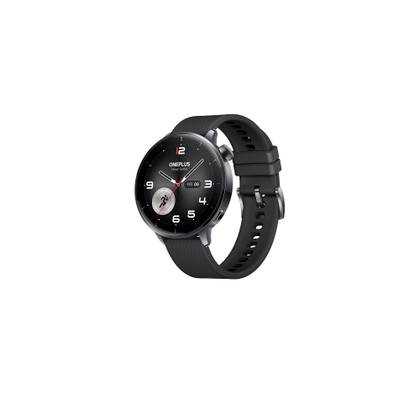While reviewing the OnePlus 15, I’ve been wearing the OnePlus Watch 3, but not the 46mm version. It is the smaller 43mm model on my wrist, and I think it’s the pick of the pair. Here’s what it’s like, and why OnePlus got its dinky smartwatch just right.
Credit: OnePlus
OnePlus Watch 3 43mm
- Case Material
-
Stainless Steel
- Case size
-
43mm
- Colors
-
Steel Black / Steel Silver
- Display
-
1.32-inches
The OnePlus Watch 3 43mm’s smaller size doesn’t mean it lacks long battery life, made possible by the innovative and efficient dual-chip, dual-OS design. The lightweight, comfortable design makes it wearable 24-hours a day.
- Compact dimensions
- Lightweight and comfortable
- Long battery life
- Bright high-res screen
- OHealth feels dated
- No Wear OS 6 update
Price, specs, and availability
The OnePlus Watch 3 43mm costs $300 and comes in Black Steel (as seen in our photos) or Silver Steel. It’s available now through OnePlus’s own online store, or from other retailers, including Amazon. This makes it one of the most affordable Android smartwatches, which is a rarity in today’s market. Both the Google Pixel Watch 4 and the Samsung Galaxy Watch 8 start at $350.
Specifications
- Case size
-
43mm
- Display
-
1.32-inches
- CPU
-
Qualcomm Snapdragon W5 Gen 1
- IP Rating
-
IP68
- Case Material
-
Stainless Steel
- Display resolution
-
466 x 466 pixels
- RAM
-
2GB
- Storage
-
32GB
- Battery
-
354mAh
- Wi-Fi connectivity
-
Wi-Fi 5
- Bluetooth
-
Bluetooth 5.2
- Software
-
Google Wear OS 5 / RTOS
- Dimensions
-
43 x 43 x 11mm
- Weight
-
37.8 grams (without band)
- Colors
-
Steel Black / Steel Silver
- ATM Rating
-
5
Small case, different materials
Not more of the same
The OnePlus Watch 43mm is not just a smaller version of the 46mm model. There are significant differences between them in the design, materials, and feel on your wrist. The case is made from stainless steel and does not have a bezel around it, but it does retain the offset crown, giving the smartwatch character. Unfortunately, it’s not sapphire glass over the screen, as you get on the 46mm version, but a simpler 2.5D glass.
It’s smoother and more tactile than the glass over the Google Pixel Watch 4’s screen, and the 2.5D shape gives it just the right amount of curve, where it catches the light and avoids looking basic and flat.
The lack of fuss and slimline band make the OnePlus Watch 3 43mm really easy to wear. Yet, it has more style and flair than the Pixel Watch 4, but manages to remain understated. There’s a wide choice of standard watch faces, covering all different styles, so there’s less need to pay for third-party ones.
The smartwatch is light at 58 grams with the band, and I’ve worn it to track sleep without any issues. The 1.32-inch screen may sound quite small, but you’re seeing it in our photos on my 6.5-inch wrist, and I think it looks just right.
I really liked the 46mm OnePlus Watch 3, but there’s no question about it being a big smartwatch, and even fans of big watches in general may find it overwhelming on their wrist. The 43mm version avoids all this, but still manages to have an individual look all of its own. Its supreme wearability makes it more suitable for more people, and proves yet again why it’s so important to make a smartwatch in more than one case size.
Software and performance
Not the latest, but you may not care
The OnePlus Watch 3 43mm uses the Qualcomm Snapdragon W5 Gen 1 processor and has Google’s Wear OS 5 installed. This means it’s a generation behind the Pixel Watch 4 in both cases, but does it make much of a difference?
I have no complaints about the performance. The smartwatch responds immediately to the screen and the rotating crown, apps aren’t hobbled by annoying loading animations, and I can smoothly scroll through data stored in health and fitness tiles.
Wear OS 6 on the Pixel Watch 4 is fantastic, and the upgrades in design are genuinely well-thought-out, making the smartwatch a joy to use. Wear OS 5 misses out on the new icon and button designs, but it’s not like stepping back in time.
OnePlus has given the available Tiles a makeover anyway, and its app grid is easy to view. The auto-brightness feature keeps the screen visible in all situations (if anything, it’s sometimes too bright), and the Quick Settings icons are all logical and sensibly spaced out on the screen.
Notifications aren’t a strong point, but this is hardly unique to the OnePlus Watch 3. Wear OS has long struggled to consistently show them, but thankfully, core apps like messages, the phone, and WhatsApp seem to operate normally.
Why isn’t Wear OS 5 and an older chip a bigger problem? The pairing works well, it’s efficient, and it has kept the price sensible.
Battery and charging
Efficiency matters
The OnePlus Watch 3 43mm has a “dual-engine architecture,” which combines the Snapdragon W5 Gen 1 with a second BES2800BP chip, which runs RTOS software. This handles basic functionality, leaving power-hungry tasks to the Snapdragon, and it dramatically increases efficiency. Best of all, you won’t know anything about it when you use the smartwatch.
This dual-chip, dual-software design means the relatively small 354mAh battery lasts for two to three days on a single charge, even when tracking sleep and a single, 30-minute GPS workout each day.
It’s not far off the battery performance I got from the 45mm Pixel Watch 4, which has a far larger capacity battery, but none of the clever chip and software magic. Battery life is always a concern on smartwatches, especially on smaller models, but there are no such issues with the 43mm OnePlus Watch 3.
I’ve been recharging it with OnePlus’s special 2-in-1 SuperVOOC charging cable, which combines the smartwatch charger with a normal USB-C connection, so you can charge your phone and watch at the same time, using a single cable. It has taken less than an hour to fully charge, and there’s a 10-minute fast charge feature for a day’s worth of battery use.
App and fitness tracking
Not all good news
The OnePlus Watch 3 43mm uses the OHealth app to connect to your phone. I had no connection issues, and it has remained solid throughout my test, but the app itself desperately needs a makeover.
OHealth has a design straight out of 2015, with lots of blank space, primary colors, and a focus on numbers. It’s not very friendly, and although there’s plenty of data, I never found myself digging into it like I do with the Oura Ring 4’s app.
Its aging design means it looks far less premium than Fitbit, Samsung Health, and Apple Health. The health and fitness Tile designs on the watch closely mirror the app, but do work better on the smaller screen.
Data collected is in line with what I regularly see from the Oura Ring 4, and workout data aligns with Fitbit, too, indicating accuracy. For sleep tracking, times, stages, blood oxygen, and resting heart rate all closely match the Oura Ring 4. However, the respiratory rate tracks consistently lower. None are medical devices, so it’s hard to say one is more accurate than the other, but it’s always good to see general consistency.
It’s worth noting that various health tracking features are turned off by default, and OHealth does not make it easy to turn them on. You will have to spend time setting all this up, and be prepared to miss features like skin temperature or constant Sp02 monitoring initially. The app’s confusing design doesn’t help.
App design aside, OHealth and the OnePlus Watch 3 provide all the daily health and fitness-tracking features you need.
Anything else to know?
Lots carried over from the 46mm version
The 43mm OnePlus Watch 3 shares a lot with the larger 46mm model. This includes an IP68 dust and water-resistance rating, 5ATM water resistance, NFC, a speaker and microphone for Bluetooth calls, more than 100 workout modes, and an extended battery mode for up to seven days of use on a single charge.
It’s so similar to the 46mm version; a lot of the things found in our review of the larger model still apply here, so it’s worth taking a good look through it before making your decision. We gave the 46mm OnePlus Watch 3 an 8/10 score, making it a recommended product.
One of the things we’d have liked not to have been carried over is software support. Both versions of the OnePlus Watch 3 use Wear OS 5, and while OnePlus has said it’ll receive two major updates, Wear OS 6 does not have an exact arrival date. It’s currently expected in 2026.
I’ve been happy with Wear OS 5, but there are some design advantages in Wear OS 6, and you can experience it on the OnePlus Watch 3’s main rivals right now. It’s probably the OnePlus Watch 3’s biggest downside.
Should you buy the OnePlus Watch 3 43mm?
Yes, the 43mm OnePlus Watch 3 is a great purchase. The compact dimensions make it suitable for most wrists, the design is classy and memorable, the battery life is excellent for such a small smartwatch, and it gives you all the health and fitness data you want.
The OHealth app lacks the same polish as the smartwatch, and its aging design means it falls behind the competition. The Wear OS 5 software is perfectly acceptable, but some may be put off by the slow update schedule. However, ignore these relatively small downsides and take the $300 price into consideration, and the OnePlus Watch 3 43mm is a good value, high-spec smartwatch anyone can wear and enjoy.
Credit: OnePlus
OnePlus Watch 3 43mm
- Case Material
-
Stainless Steel
- Case size
-
43mm
- Colors
-
Steel Black / Steel Silver
- Display
-
1.32-inches
The OnePlus Watch 3 43mm includes everything that makes the 46mm such a great buy — screen, battery life, and performance — but without the large case, making it more comfortable to wear long-term. The fact it’s a little cheaper makes it an even better buy.












